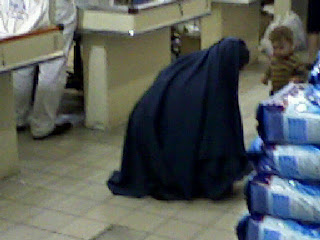
Rafi of Life in Israel took these pictures at a grocery store in Beit Shemesh today, and generously allowed me to post them. (You can see his post here).

The woman is not the only one taking on extra layers; Rafi reports that the man accompanying her, presumably her husband, is wearing at least three pairs of tzitzit (ritual fringes). The little boy, though, is wearing typical “western” clothing.
Not all of the women who cover up are Keren’s followers. But this woman is not wearing the “shal” typical of many Breslover returnees to Judaism.

 Compare her dress with the woman below, who does have on a “shal.”
Compare her dress with the woman below, who does have on a “shal.”
 Too bad Rafi and his wife didn’t get an interview. . .
Too bad Rafi and his wife didn’t get an interview. . .
Related Posts:
my wife thought I was crazy taking pictures
she was worried they would see and kill me
The only Breslover I know is a man who teaches at my brother’s school and he only wears one talit, under his shirt (but with his tzitzit showing). Do many Breslov women dress in the hyper-tznius style? Or just Breslov BTs? Or…?
Rafi wrote in his comments that something in the store is blocking him.
Fern, many of the shal-wearers are Breslovers. But not all Breslovers wear shals–Noa Yaron doesn’t.
Is that guy missing a head?
Neshama, one woman I spoke to who wears a shal said it refers to the cape or cloak over the clothes. It doesn’t refer to the head-covering.
I don’t know what you wear (maybe post a picture?) but there are certainly many women wearing various types of elaborate scarves.
Thanks for your comment.
This is very interesting.
I know a frum woman in Yerushalayim that wears a shawl, but she is not Breslov. Many of these women have Rabbinic guidance from well-placed neshomos in Yerushalayim. I am sure the “Burqa” incident has set them back a bit. (Such a sad, sad story.)
Just as an aside: I chose not to wear a sheitel, and some very attractive head-coverings resemble what in one picture is called a “shal”. These are not strange coverings, and can come in various patterns to complement one’s outfits. Has anyone seen them in Israel?
Maybe they are filming a video?
The thing that kills me is you have really good movements, like Breslav ba’al teshuva movements, that bring in a large community of normal people. The people that get attention, of course, are these guys, and they make the whole group of ba’alai teshuva seem nuts.
NPR had a woman on that writes for The Times (Sheera Frankel), and she essentially said that ba’alai teshuva people go overboard.
I don’t think I’ve gone overboard. I’m pretty mainstream, and all my ba’al teshuva friends are mainstream.
This just sets us back a little as an entire community. Forget the burqa incident setting back one movement!
I say live and let live. I am surprised that this would draw such public comment, given that many of us as Orthodox Jews do things that others may find odd. The traditions, rituals, sheitels, black clothes, and fuzzy hats…
It is not the place of one in the frum community to judge the other, especially since noone actually knows this particular couple or why they choose to dress as they do.
Even if we did know some facts, it seems that big assumptions are being made without trying to understand that some people just have their own way of living. It really can be as simple as that.
The only thing I find sad in all this is the mocking of this couple by other Jews.
Oy.
Fern, many of the shal-wearers are Breslovers. But not all Breslovers wear shals–Noa Yaron doesn’t.
Gotcha.
Danny–I’m with you on that front. I’m normal looking and acting. I am sure that 99% of the time, when I go out, no one other then fellow Jews realizes that I’m Jewish (it seems that frum women are always on the look out for fellow long-skirt-wearers). And most of the BTs I know are also pretty normal people. It’s a shame that a few bad apples tarnishes the reputation of thousands of good ones.
Chanie, I didn’t put up the pictures in order to mock this couple. I am interested in this new way of dressing as a sociological and religious phenomenon. I am disturbed by the climate that encourages women to cover up so much. They didn’t wake up one day and decide to try a new style.
Thank you for your comment and I appreciate the reminder to all of us to keep the discussion respectful.
Danny, “anyone to the left of me is a fanatic.” I am sure that the BTs you describe feel they are simply being serious about their Judaism, and who can fault them for that? The problem is when their teachers emphasize the wrong things, and don’t teach them the difference between halacha and a chumra. Unfortunately many Israeli BTs today jump in without doing much serious learning, especially women.
She shows her face. The clothes are like an old time nun. the hats are good protection against skin cancer.
I don’t find the whole thing very surprising. Over the ages, Jews have always taken on the dress habits of the local non-Jews. Where do you think the clothes traditional Temanim wear? And where do you think the clothes Charedim wear came from? From the local noblemen in Eastern Europe!
Now, some Jews are adopting the dress habits of the local Arabs! 🙂
Mark, actually the Temanim didn’t adopt their particular clothing, they had it since the 1st temple period and the Arabs via Mohamed (who lived in Yemen early on) aped jewish culture.
The problem isn’t when an individual wants to do this but when the husband is trying to coerce or force the wife
to dress in this manner. I know someone going thru this now.
Tess
Tess, I am skeptical that the Temanim kept their dress from the First Temple period, but I haven’t researched the subject.
In most of the cases the wife had to convince the husband that it was okay for her to wear a shawl, and in the one case mentioned in the paper, the rabbinic court sided with the husband and granted a divorce. I don’t know what would happen if the husband felt his wife should dress that way.